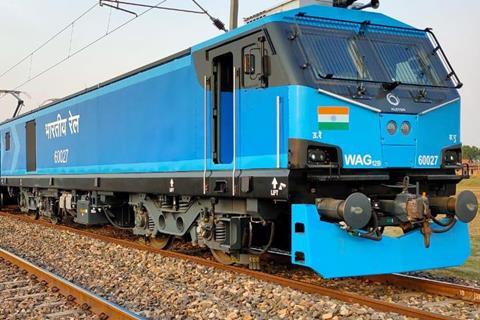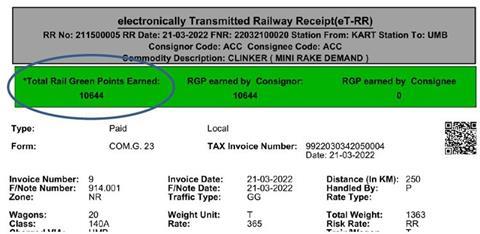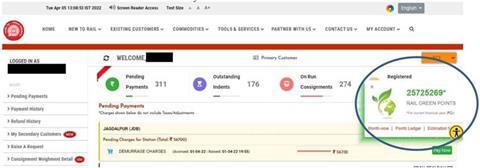
INDIA: In order to incentivise its corporate customers to mitigate their carbon emissions and simultaneously enhance its freight loadings, Indian Railways has launched a ‘Rail Green Points’ scheme highlighting the environmental advantages of shipping freight by rail rather than road.
As part of its Nationally Determined Contributions under the UN climate change mitigation strategy, the Indian government has set a target of reducing its overall emissions by 33%. Transport is seen as a key sector with substantial mitigation potential, particularly if IR can enhance its share of land-based freight transport from less than 30% at present to 45% by 2030.
The Rail Green Points initiative is intended to make freight customers aware of the greenhouse gas emissions that they have saved by transporting their freight by rail. Authorised by the IR Board earlier this year, the scheme was put into operation with effect from April 1.
The RGP initiative uses an emissions calculator developed by the Energy & Resource Institute to estimate GHG emissions in terms of tonnes of CO2 equivalent per tonne-km. This currently uses conversion rates of 0·009 kg CO2/t-km for rail and 0·040 kg for road, although TERI indicates that the emissions factor may be subject to modification from time to time.
Digital credits

IR’s Centre for Rail Information Systems has developed a digital module for calculating and awarding Rail Green Points automatically using booking data from the Freight Operations Information System.
IR already had a smart freight calculator on its website which customers can use to calculate freight rates for transporting cargo from one station to another. It also provides other information such as estimated transit times, available facilities and logistics service providers at the origin and destination terminals. With the introduction of RGPs, the smart freight calculator has been modified to display savings in GHG emissions compared to an equivalent movement by road, estimated on basis of net tonne-km.
Whenever a customer books a freight movement and orders wagons online, they receive a pop-up message thanking them for choosing to transport their goods by rail, along with details of the expected saving of carbon emissions. The RGPs and carbon savings are also printed on the electronic Railway Receipts which authorise the recipient to take delivery of the goods at the destination.
Whenever a receipt is generated, the RGP account of the registered freight customer is credited in real time. This gives the customer a cumulative points total that can be seen in their account on IR’s Freight Business Development portal.
IR emphasised that RGPs will be only be credited to registered customers, and they cannot be transferred from one account to another. If the consignor and consignee are different, and both are registered, the RGPs credited for a given movement will be distributed equally between the two. In the event that only one is registered, all of the RGPs will be credited to the registered customer. If a movement is booked using a physical waybill rather than an electronic one, the RGPs would be credited to the consignor.
Feel-good factor

Recognising that responsible companies — and particularly large multinationals — are looking to be seen as sustainable, and contributing to combatting climate change, IR hopes that the RGP scheme and emissions information will create a ‘feel good factor’ that will motivate customers to transport more by train. Stellar Value Chain Solutions Chairman & Managing Director Anshuman Singh tracks sustainability initiatives for a number of major companies, and he says many are increasingly willing to pay a small premium for ‘going green’.
The RGP data will enable corporate customers to present their carbon savings in their annual balance sheet or sustainability reports. It may also encourage them to earn additional points to present themselves as more environment-friendly organisations. CRIS is therefore looking at developing some form of Green Star rating for ranking IR’s rail freight customers based on the RGPs that they earn in each financial year.
In launching the scheme, IR added a clear disclaimer, that there is no link between Railway Green Points and any form of carbon credits. The carbon savings calculated for the RGP scheme are only indicative, being estimated as it is on basis of average carbon emissions per tonne-km. Nor does the nominal carbon savings entitle the customer to any monetary benefit or compensation from the railway.
As operator of the world’s fourth largest railway network, Indian Railways currently runs around 9 000 freight trains per day, transporting an average of more than 3 million tonnes. Traffic increased significantly during the coronavirus pandemic, with IR carrying a record 1 418·1 million tonnes in the 2021-22 financial year to March 31. This was 15% up on the 1 233·3 million tonnes reported in 2020-21.

















